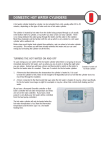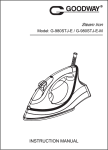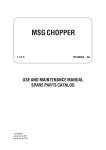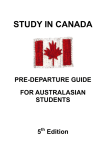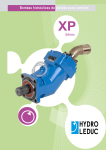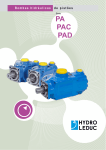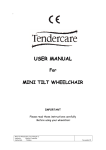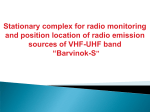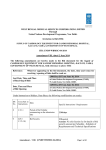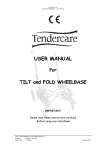Download OPERATING GUIDELINES
Transcript
17 January 2002 INTRODUCTION TO SOUND MEASUREMENT GUIDELINES Excessive noise is not only socially unacceptable to the vast majority of New Zealanders, it can cause irreparable damage to a person’s hearing. A noisy exhaust seems to be an integral part of the culture of ‘boy racers’ and people of similar ilk. In an effort to curb this aspect of their anti-social and often dangerous behaviour we intend to pay particular attention to the existing regulations relating to noise output. The following instructions for the measurement of noise emissions from motor vehicles are intended merely as a guide. They are based around the requirements set out in “British Standard for the Measurement of Noise Emitted by Motor Vehicles – BS3425” and “Australian Design Rule 28/01 – External Noise of Motor Vehicles”, copies of which can be obtained from Traffic Operations Support, Office of the Commissioner. When considering whether or not to take enforcement action under regulation 29(1) of the Traffic Regulations 1976 you will need to have regard to a number of matters including:The manner of operation of the vehicle; The condition of the vehicle; The time of day when the noise is created; The locality where the noise is created; The likelihood of annoyance The use of a noise level meter is to provide corroborative evidence that a motor vehicle was in breach of regulation 29(1). The meters should not be used as evidence that a motor vehicle exceeded the maximum permissible noise level. Provided some or all of the five points listed in regulation 29(1) can be proved, the fact that the noise from an exhaust may be less than the recommended tolerance level would not preclude the issue of an infringement notice for operating a noisy motor vehicle. In such circumstances, however, placing the vehicle out of service under section 115(1) of the Land Transport Act 1998 would not be appropriate. If a vehicle is placed out of service for excessive noise, the driver and/or owner should be advised to take their vehicle to a testing station for the issue of a new warrant of fitness. Staff at these facilities are better qualified to inspect and rule upon nonstandard exhausts. The requirement that a vehicle be taken only to a testing station is supported by section 115(2) Land Transport Act 1998 “(2)A notice given under subsection (1) continues in force until the vehicle has been made to comply with the provisions of the regulations and the rules, and new evidence of vehicle inspection has been issued for the vehicle by a person authorised by the Director and is displayed on the vehicle.” Clause 2 of the Land Transport (Ordering Vehicles Off the Road) Notice 1999 says – ``Authorised vehicle inspection agent'' means a person authorised by the Land Transport Safety Authority to inspect vehicles and issue evidence of vehicle inspection who does not engage in repairing vehicles in the course of business” Operating distances and tolerances are based on tests using the Digital Sound Level Meter available from Dick Smith Electronics (Catalogue Number Q1362). If you require further operational support it is suggested that you contact your local authority’s Environmental Health Officer. These individuals can provide information and sound measuring devices. Furthermore, Professor Philip Dickinson from the Massey University Sound Laboratory has also shown his support for the scheme. He has indicated a willingness to provide technical advice and evidence should it be needed. He can be contacted on (04) 801 2794 (extn 6478). Ian James Inspector OPERATING GUIDELINES 8 1. ON / OFF Button 7 2. RECORD Button 3. FAST / SLOW Button 4. RANGE Button 5. WEIGHTING Button 1 2 3 6. MAX HOLD Button 7. Decibel Reading 4 5 6 8. The Microphone Part 1 – Meter Working Instructions 1. Measuring Sound Levels Press the ON / OFF button (1) to turn the meter on. The unit display will count down from 99.9 and then will begin measuring current sound levels. Point the microphone towards the source of the sound to be measured (refer to Part 2 - Operating Instructions). 2. Using the MAX HOLD Function The MAX HOLD function freezes the display at the level of the loudest detected sound for a given period. To use the MAX HOLD function: When ready to measure a period of noise, press the MAX HOLD button (6). MAX HOLD will be displayed in the upper left-hand corner of the display. The digital display will remain unchanged until a higher reading is detected and remain so until the function is disabled. Press the MAX HOLD button (6) again to disable the function (N.B. You will lose the maximum reading as soon as you do). 3. Using the RECORD Function The unit can also record and store the maximum and minimum sound levels for a given period using the RECORD function. To use the RECORD function: When ready to measure a period of noise, press the RECORD button (2). REC will be displayed in the upper left-hand corner of the display. When the required period is finished, press the RECORD button (2) again. MIN will appear in the upper middle of the display and the minimum sound level will be displayed. Press the RECORD button (2) again. MAX will be displayed in the upper left of the display. The display now shows the maximum sound level recorded. To restart recording, press the RECORD button (2) again. To exit recording, press and hold the RECORD button (2) until REC disappears from the upper left-hand corner of the display. For all other functions, refer to the Owner’s Manual included with the meter. However, it is recommended that the automatic start-up settings be used when taking readings. Part 2 - Operating Instructions 1. Measuring the Noise Output of Motor Vehicles When measuring the noise generated by a motor vehicle: The meter should be held no closer then 1 metre from the end of the vehicle and 1 metre to the side of the exhaust outlet, positioned 1.2 metres above the ground (approximately waist height). Direct the meter at the exhaust outlet. Ask the driver of the target vehicle to quickly rev the vehicle to approximately 3000 – 4000 rpm’s but less then any maximum revs marked on the vehicles rev counter. 3000 / 4000 rpm 1m 1m 1m THE METER SHOULD BE SET TO ITS DEFAULT SETTINGS WHEN MEASURING NOISE (i.e. “A” and “FAST” should be displayed in the right-hand side of the display). It is also worth noting that: An area 3m in radius and consisting of concrete or asphalt is ideal for measurement, free of long grass and loose soil. Buildings or other large objects such as fences may reflect sound (i.e. echoes). Large groups of people tend to absorb (and produce) sound. Try to restrict the number of observers within the vicinity of the meter or its microphone to two. Wind gusts and other background noise at time of measurement could distort any measurement. 2. Number of Measurements Conduct THREE readings from the same location using the RECORD function described previously. Take the AVERAGE of the three readings and compare this with the table provided below. 3. Enforcement Action Where the average of the three readings exceeds the “Tolerance” level in the following table, you: SHOULD place the vehicle out of service under s.115(1) Land Transport Act, 1998 (Green Sticker). Vehicles placed out of service are to be taken to a testing station for the issue of a replacement warrant of fitness. MAY issue an infringement notice using Prec N101, Noisy Motor Vehicle. Noise Level (dBA) Tolerance (dBA) Moped 77 81 Motor cycle having an engine capacity of 125cm3 or less 82 86 Motor cycle having an engine capacity of more than 125cm3 86 90 Motor vehicle (being a motorcar, van, or light truck) having a gross vehicle weight of 3,500kg or less 81 85 Motor vehicle having a gross vehicle weight of more than 3500kg and having an engine with a power output of 150 kW or less 86 90 Motor vehicle having a gross vehicle weight of more than 3500kg and having an engine with a power output of more than150 kW 88 92 Vehicle Type Based on First Schedule, Reg 29(2), Traffic Regulations 1976







